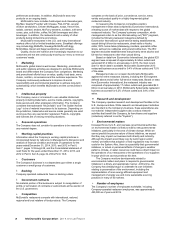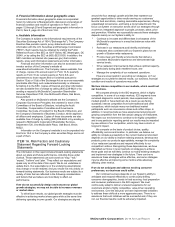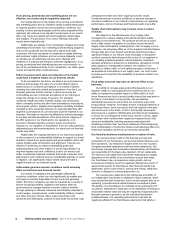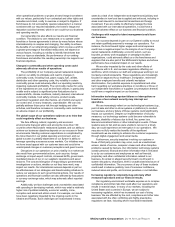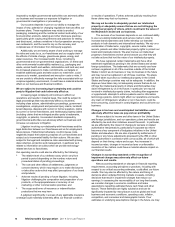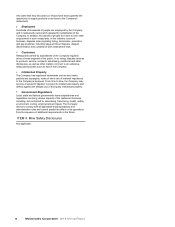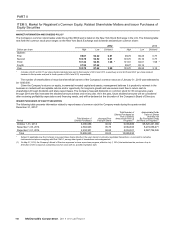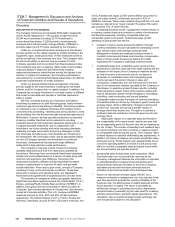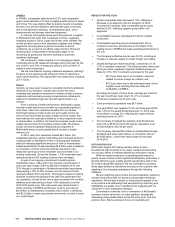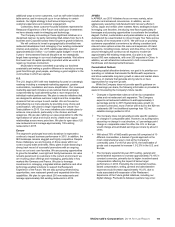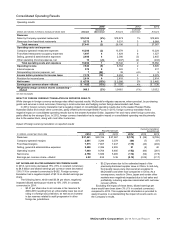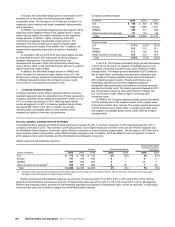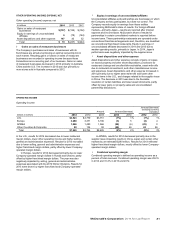McDonalds 2014 Annual Report Download - page 18
Download and view the complete annual report
Please find page 18 of the 2014 McDonalds annual report below. You can navigate through the pages in the report by either clicking on the pages listed below, or by using the keyword search tool below to find specific information within the annual report.
12 McDonald’s Corporation 2014 Annual Report
ITEM 7. Management’s Discussion and Analysis
of Financial Condition and Results of Operations
Overview
DESCRIPTION OF THE BUSINESS
The Company franchises and operates McDonald’s restaurants.
Of the 36,258 restaurants in 119 countries at year-end 2014,
29,544 were franchised (including 20,774 franchised to
conventional franchisees, 5,228 licensed to developmental
licensees and 3,542 licensed to foreign affiliates ("affiliates")—
primarily Japan) and 6,714 were operated by the Company.
Under our conventional franchise arrangement, franchisees
provide a portion of the capital required by initially investing in the
equipment, signs, seating and décor of their restaurant business,
and by reinvesting in the business over time. The Company owns
the land and building or secures long-term leases for both
Company-operated and conventional franchised restaurant sites.
This maintains long-term occupancy rights, helps control related
costs and assists in alignment with franchisees enabling
restaurant performance levels that are among the highest in the
industry. In certain circumstances, the Company participates in
reinvestment for conventional franchised restaurants in an effort to
accelerate implementation of certain initiatives.
Under our developmental license arrangement, licensees
provide capital for the entire business, including the real estate
interest, and the Company has no capital invested. In addition, the
Company has an equity investment in a limited number of affiliates
that invest in real estate and operate or franchise restaurants
within a market.
We view ourselves primarily as a franchisor and believe
franchising is paramount to both delivering great, locally-relevant
customer experiences and driving profitability. Franchising enables
an individual to own a restaurant business and maintain control
over personnel, purchasing, marketing and pricing decisions, while
also benefiting from the financial strength and global experience of
McDonald's. However, directly operating restaurants is important
to being a credible franchisor and is essential to providing
Company personnel with restaurant operations experience. In our
Company-operated restaurants, and in collaboration with
franchisees, we further develop and refine operating standards,
marketing concepts and product and pricing strategies, so that
only those that we believe are most beneficial are introduced in
the restaurants. We continually review, and as appropriate adjust,
our mix of Company-operated and franchised (conventional
franchised, developmental licensed and foreign affiliated)
restaurants to help optimize overall performance.
The Company’s revenues consist of sales by Company-
operated restaurants and fees from restaurants operated by
franchisees. Revenues from conventional franchised restaurants
include rent and royalties based on a percent of sales along with
minimum rent payments, and initial fees. Revenues from
restaurants licensed to affiliates and developmental licensees
include a royalty based on a percent of sales, and generally
include initial fees. Fees vary by type of site, amount of Company
investment, if any, and local business conditions. These fees,
along with occupancy and operating rights, are stipulated in
franchise/license agreements that generally have 20-year terms.
The business is managed as distinct geographic segments.
Significant reportable segments include the United States ("U.S."),
Europe, and Asia/Pacific, Middle East and Africa ("APMEA"). In
addition, throughout this report we present “Other Countries &
Corporate” that includes operations in Canada and Latin America,
as well as Corporate activities. The U.S., Europe and APMEA
segments account for 32%, 40% and 23% of total revenues,
respectively. The United Kingdom ("U.K."), France, Russia and
Germany, collectively, account for 68% of Europe’s revenues; and
China, Australia and Japan (a 50%-owned affiliate accounted for
under the equity method), collectively, account for 52% of
APMEA’s revenues. These seven markets along with the U.S. and
Canada are referred to as “major markets” throughout this report
and comprise 75% of total revenues.
In analyzing business trends, management reviews results on
a constant currency basis and considers a variety of performance
and financial measures, including comparable sales and
comparable guest count growth, Systemwide sales growth,
operating income growth and returns.
Constant currency results exclude the effects of foreign
currency translation and are calculated by translating current
year results at prior year average exchange rates.
Management reviews and analyzes business results in
constant currencies and bases most incentive compensation
plans on these results because we believe this better
represents the Company’s underlying business trends.
Comparable sales and comparable guest counts are key
performance indicators used within the retail industry and are
indicative of the impact of the Company’s initiatives as well
as local economic and consumer trends. Increases or
decreases in comparable sales and comparable guest
counts represent the percent change in sales and
transactions, respectively, from the same period in the prior
year for all restaurants, whether operated by the Company or
franchisees, in operation at least thirteen months, including
those temporarily closed. Some of the reasons restaurants
may be temporarily closed include reimaging or remodeling,
rebuilding, road construction and natural disasters.
Comparable sales exclude the impact of currency translation.
Comparable sales are driven by changes in guest counts and
average check, which is affected by changes in pricing and
product mix. Typically, pricing has a greater impact on
average check than product mix. The goal is to achieve a
relatively balanced contribution from both guest counts and
average check.
McDonald’s reports on a calendar basis and therefore
the comparability of the same month, quarter and year with
the corresponding period of the prior year will be impacted by
the mix of days. The number of weekdays and weekend days
in a given timeframe can have a positive or negative impact
on comparable sales and guest counts. The Company refers
to these impacts as calendar shift/trading day adjustments. In
addition, the timing of holidays can impact comparable sales
and guest counts. These impacts vary geographically due to
consumer spending patterns and have a more pronounced
effect on monthly comparable sales and guest counts while
the annual impacts are typically minimal.
Systemwide sales include sales at all restaurants. While
franchised sales are not recorded as revenues by the
Company, management believes the information is important
in understanding the Company’s financial performance
because these sales are the basis on which the Company
calculates and records franchised revenues and are
indicative of the financial health of the franchisee base.
Return on incremental invested capital ("ROIIC") is a
measure reviewed by management over one-year and three-
year time periods to evaluate the overall profitability of the
business units, the effectiveness of capital deployed and the
future allocation of capital. The return is calculated by
dividing the change in operating income plus depreciation
and amortization (numerator) by the cash used for investing
activities (denominator), primarily capital expenditures. The
calculation uses a constant average foreign exchange rate
over the periods included in the calculation.


